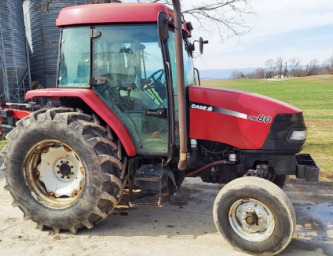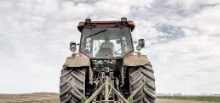________________________________________________________________________________________
| Home / Farm Tractors / Case IH Tractors / Case IH CX80 |
Case IH CX-80 Troubleshooting
 The
Case IH CX80 is a 2WD or 4WD tractor from CX utility series. This model was
manufactured from 1998 to 2002. The Case IH CX-80 tractor is powered by 243.5
cu.in (4 L) Perkins 1004.40T 4-cylinder turbocharged diesel engine with a rated
power of 84 hp (62.6 kW).
The
Case IH CX80 is a 2WD or 4WD tractor from CX utility series. This model was
manufactured from 1998 to 2002. The Case IH CX-80 tractor is powered by 243.5
cu.in (4 L) Perkins 1004.40T 4-cylinder turbocharged diesel engine with a rated
power of 84 hp (62.6 kW).
The tractor is fitted with a three types of transmission. Type 1: 8x8 synchro-shuttle transmission. Type 2: 16x8 powershift transmission. Type 3: 24x12 powershift transmission with creeper. The maximum forward speed - 24.4 mph (39.2 kph), maximum reverse speed - 22.1 mph (35.5 kph).
The open center hydraulic system includes a gear pump with rated fluid flow of 15.7 gal/min (59.4 l/min). The system relief pressure is 173 bar (2500 psi). The two-wheel drive models are equipped with 7.50x16 front tyres and 16.9-30 rear tyres. The 13.6R24 front tyres and 18.4R34 rear tyres fit four-wheel drive tractors. The Case IH CX80 tractor can be equipped with the following attachments: Case IH 2255 loader with lift capacity to full height of 2500 lbs (1134 kg) and breakout force of 4000 lbs (1814 kg).
| Engine Troubleshooting |
| Engine difficult to start or doesn't start |
Air trapped in fuel system - Bleed air.
Fuel filter plugged - Filter maintenance required.
Fuel injection nozzles fault - Check and replace nozzles if required.
Water in the fuel system - Change fuel and repair fuel system.
Valve clearance is wrong - Need to adjust valve clearance.
Faulty fuel injection pump - Repair or install a new fuel pump.
| Engine starts and immediately shuts off |
Dirty air cleaner - Install new air filter element.
Dirty fuel filter - Clean the filter or install new filter element.
Problems with fuel injection pump tightness - Inspect fuel injection pump for leaks.
Defective fuel injectors - Change or clean fuel injectors.
Fuel injection pump is broken - Replacement or repair required.
| Engine stalls while running |
Low coolant temperature - Normalize the temperature by warming up the engine.
Fuel filter plugging - Clean or replace the filter.
There is air in the fuel system - Bleed the system.
Faulty or dirty injection nozzles - Clean or replace injection nozzles.
Fuel injection pump timing is not adjusted - Set the fuel pump timing correctly.
| Engine stops while idle |
Incorrectly set low idle speed - Test and adjust.
Fuel injection pump is defective - Replace injection pump or repair it.
Defective fuel injectors - Change or clean fuel injectors.
The valve clearance is not adjusted - Adjust valve clearance.
| Poor engine power |
Dirty air filter - Carry out maintenance on air filter.
Dirty or faulty injection nozzles - Service or change injection nozzles.
Fuel injection pressure is wrong - Correct the pressure settings.
Excessive valve clearance - Adjust to proper valve clearance.
Low idle speed setting is not correct - Need to adjust idle speed.
Clogged fuel lines or hoses - Clean fuel lines and hoses.
Cylinder head gasket is blown - Install new cylinder head gasket.
Worn or damaged piston rings - Replace piston rings.
| Engine overheated |
Engine coolant is insufficient - Top up coolant fluid and check system for leaks.
Not enough engine oil - Check and refill engine oil.
Defective radiator cap or clogged radiator core - Clean radiator or change cap.
Damaged or worn fan belt - Belt replacement is recommended.
Engine is running overloaded - Reduce the load or operate the tractor in lower gears.
| Oil pressure is insufficient |
Engine oil level low - Add oil to the engine crankcase.
Clogged oil filter element - Change or service engine oil filter.
Oil grade or viscosity is incorrect - Use the specified type of engine oil.
Incorrect oil clearance in main bearing - Install new bearings.
Oil pump is defective - Replace as required.
| Abnormal engine noise or knocking |
Not enough engine oil - Check oil level and add oil as required.
Engine is not preheated - Warm up engine as required.
Improper fuel injection timing - Set the fuel pump timing correctly.
Too low idle RPM - Adjust as required.
Defective fuel injectors - Replace fuel injectors.
Connecting rod is misaligned or worn - Connecting rod needs to be replaced or aligned.
Piston wear or scoring - Install new pistons.
| Transmission Troubleshooting |
| Transmission fluid pressure is insufficient |
Lack of transmission oil supply - Need to add transmission oil.
Transmission oil filter is dirty (if equipped) - Service or replace the transmission oil filter.
Relief valve failure - Replace valve as required.
| Transmission noises |
Lack of transmission oil supply - Add oil to the transmission housing.
Transmission fluid is contaminated - Change the fluid.
Damaged gears or incorrect backlash - Replace defective gears or set backlash properly.
Bearings are damaged or worn - Bearings need to be changed.
Worn or bent shift forks - Shift forks need to be replaced.
Shaft splines are worn or stuck - Change the shaft.
| Difficulty shifting gears |
Worn or rusty gear shift linkage - Change or lubricate shift linkage.
Shift forks are bent or worn out - Shift forks need to be replaced.
Worn gear shifting mechanism - Repair or change worn components if necessary.
Malfunction or incorrect clutch adjustment - Adjust or install new clutch.
| External fluid leaks |
Transmission fluid level is exceeded - Excess fluid must be drained.
Damaged seals or gaskets - Change defective seal or gaskets.
| Hydraulics Troubleshooting |
| Hydraulic fluid pressure is insufficient |
Low hydraulic fluid level - Checking hydraulic fluid level and add if necessary.
Clogged hydraulic fluid filter element - Clean the hydraulic filter element or replace if necessary.
Hydraulic pump is faulty - Repair or replace hydraulic oil pump.
Not adjusted hydraulic control valve - Need to adjust.
Hydraulic cylinder failure - Repair or change hydraulic cylinder.
Leaks in hydraulic lines - Check the system and repair leaks.
| Hydraulic system is too hot |
Damaged main relief valve - Replace relief valve.
Improper type of hydraulic oil - Use the proper type of oil.
Dirty hydraulic fluid - The fluid must be changed.
Air in hydraulic system - Bleed air from hydraulic system.
| Hitch can't lift or lifts too slowly |
Heavy load on the hitch - The load should be reduced.
Hydraulic oil is insufficient - Check and refill the hydraulic oil.
Clogged hydraulic fluid filter - Clean or change hydraulic filter.
Damaged hydraulic pump - Replace or repair hydraulic fluid pump.
Damaged main relief valve - Relief valve need to be replaced.
Defective hydraulic spool valve block - Repair or change the valve.
Hydraulic cylinder is defective - Install a new hydraulic cylinder or repair it.
Loose or broken suction line - Tighten the pipe or replace it.
| Hitch won't drop or drops slowly |
Not adjusted hydraulic control valve - Need to adjust.
Hydraulic cylinder is broken - Change or repair hydraulic cylinder.
Three-point hitch has not been adjusted - Adjust three-point hitch as required.
Damaged lift arm shaft - Install a new shaft.
| 3-point hitch jerks when lower or lift |
Air in hydraulic system - Bleed air from hydraulic system.
Hydraulic fluid is dirty - Hydraulic fluid change required.
Hydraulic pump is defective - Replace or repair hydraulic fluid pump.
Hydraulic spool valve block is defective - Repair or change hydraulic valve.
Hydraulic cylinder not working - Replace or repair hydraulic cylinder.
| Steering System Troubleshooting |
| Steering wheel is hard to turn |
Improperly installed or damaged steering column - Install the steering column as required or replace it.
Air trapped inside steering system - Air-bleed steering system.
Not adjusted toe-in - Check toe-in and correct.
Tires have uneven wear - Replace the tires.
Steering pump not working - Check the hydraulic steering pump and change if necessary.
Stuck or damaged steering pump control valve - Install a new flow control valve or clean it.
Not enough steering oil - Check oil level and add steering oil as required.
| Excessive play in steering |
Steering column coupling or shaft has maximum wear - Change faulty part.
Steering pump stopped working - Steering pump needs to be replaced or repaired.
Steering linkage joints are worn or loose - Replace or repair steering linkage.
| Tractor pulls to left or right |
Tire pressure is uneven - Adjust the tire pressure.
Not adjusted toe-in - Check and adjust toe-in.
Steering linkage joints are worn or loose - Repair or replace steering linkage.
Front wheel bearings are defective or improperly adjusted - Change or adjust the bearings properly.
| Electrical Troubleshooting |
| Battery cannot be charged |
Corroded or loose cable connections - Clean or tighten wiring connections.
Faulty battery terminal clamps - Terminal clamps need to be replaced.
Defective battery - Battery replacement required.
Belt is worn or loose - Belt needs to be adjusted or changed.
| Starter motor cranks slow |
Low battery output voltage - Charge the battery.
Battery is not holding charge - Battery needs service or replacement.
Disconnected cables or faulty battery terminals - Check wiring connections and replace or clean terminals.
| Starter is not working |
Battery is drained or defective - Charge or change the battery.
Battery wires are disconnected or incorrectly connected - Check wires and connect correctly.
Low battery voltage - Charge the battery.
Faulty starter motor - Starter should be replaced.
________________________________________________________________________________________
________________________________________________________________________________________
| Farm Tractors Technical Specifications |
